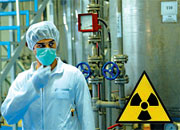The Practice of Paediatric Radiation Oncology in Low and Middle Income Countries study, published this month in the journal Clinical Oncology, surveyed 134 radiotherapy centres in 42 countries to better understand the status of paediatric radiotherapy worldwide. Results show that, like other medical subspecialities, paediatric radiotherapy in low resource settings faces many obstacles: equipment is scarce and outdated, and there is a severe lack of radiation oncologists and other specialized radiation medicine staff.
Although rare, childhood cancer represents the fourth most significant type of cancer after lung, breast, and colorectal cancers due to the potential life years that may be lost. Many paediatric cancers respond well to treatment, and more than 80 per cent of children in high income countries are cured, according to World Health Organization (WHO) data. In low resource countries, however, less than 20 per cent of children survive it due to delayed diagnosis, inaccessible or uncompleted treatment, or because the cancer is combined with an existing condition such as malnutrition.
“It is a huge difference, especially since the vast majority of children are born in low and middle income countries,” said Kirsten Hopkins, a radiation oncologist at the IAEA. “Combined with chemotherapy and surgery, radiotherapy is essential for around one third of children cancer patients,” she added. Radiation can be used to effectively treat brain, bone, and kidney tumours, among others, as well as soft tissue sarcoma – a type of cancer affecting connective tissues such as muscles.
The study highlights that the survival of children with cancer in high income countries increased significantly from the 1970s with the optimum use of early chemotherapy and Cobalt-60 radiotherapy machines. “It’s a great medical success story of the last decades, and it now needs to be extended to where the majority of children actually live,” Hopkins said.
While low income countries often lack adequate radiotherapy to treat cancer in general, the study noted that enhanced multidisciplinary clinical management and collaboration between health authorities, academic institutions and international organisations could help improve its use in paediatric oncology.
In addition to the broad survey, the study closely reviewed practices in eight leading middle income country treatment centres, showing that “good paediatric radiotherapy is possible when these centres adopt modern approaches and radiation specialists work in close collaboration with other oncology and paediatric teams,” said co-author Yavuz Anacak from the Department of Radiation Oncology at the Ege University School of Medicine and Hospital in Izmir, Turkey. “This seems to be a good target for partnerships.”
The study also found that other infrastructure necessary for best paediatric radiotherapy practice was inadequate or not available in many treatment centres around the world. This includes immobilization equipment in child sizes, anaesthesia equipment and post-anaesthesia recovery rooms, play areas and the availability of support staff experienced in childcare, such as nurses and social workers. Deficiencies were also noted in training, as paediatric radiotherapy was not part of the curriculum in many countries and radiation oncology graduates had little or no experience in treating children.
“Children are not just little adults, they are a whole group in themselves,” Hopkins said. The quality of radiotherapy treatment is essential, she added, particularly as children’s cells are more sensitive to radiation because of division and growth. This puts them at a higher risk of late side effects that could impact learning and development.
Studies such as these, added Hopkins, offer a roadmap to plan assistance to countries in battling a growing cancer burden, also in children. “We have identified gaps and know where to focus beyond the provision of equipment, such as by supporting training in multidisciplinary approaches for paediatric cancer management.”
The IAEA assists countries in improving nuclear and radiation medicine, including through the provision of guidance, equipment, and training. The IAEA is part of the WHO’s Global Initiative for Childhood Cancer, which aims to ensure that 60 per cent of children will survive cancer by 2030, and has since 2014 invested over €47 million in support to radiation oncology services, including for paediatric cancer. The Agency is also developing guidelines to help health planners and practitioners in low income settings ensure that requirements for safe and effective paediatric radiotherapy are reflected in cancer management and service planning.
.jpeg)
Staff at the Children’s Hospital Teletón de Oncología in Querétaro, Mexico put a young patient at ease before she receives radiotherapy treatment. (Photo: A Silva and J Weilguny/IAEA)


